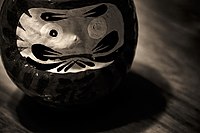| Revision as of 15:00, 26 May 2007 edit84.220.20.223 (talk)No edit summary← Previous edit | Revision as of 02:16, 1 June 2007 edit undoJFD (talk | contribs)Extended confirmed users7,235 edits redundantNext edit → | ||
| Line 5: | Line 5: | ||
| ] | ] | ||
| {{nihongo|'''Daruma dolls'''|達磨|daruma}}, also known as '''dharma dolls''', are hollow and round ]ese wish dolls with no arms or legs, modelled after ], the founder and first patriarch of ]. |
{{nihongo|'''Daruma dolls'''|達磨|daruma}}, also known as '''dharma dolls''', are hollow and round ]ese wish dolls with no arms or legs, modelled after ]. Typical colors are red (most common), yellow, green, and white. The doll has a face with a moustache and beard, but its eyes only contain the color white. Using black ink, one fills in a single circular eye while thinking of a wish. Should the wish later come true, the second eye is filled in. | ||
| ==Characteristics== | ==Characteristics== | ||
Revision as of 02:16, 1 June 2007
- Daruma is also the Japanese name for Bodhidharma.


Daruma dolls (達磨, daruma), also known as dharma dolls, are hollow and round Japanese wish dolls with no arms or legs, modelled after Bodhidharma. Typical colors are red (most common), yellow, green, and white. The doll has a face with a moustache and beard, but its eyes only contain the color white. Using black ink, one fills in a single circular eye while thinking of a wish. Should the wish later come true, the second eye is filled in.
Characteristics
Because of their low centers of gravity, some types of daruma doll return to the upright position after being tilted to one side. As such, the daruma has become symbolic for optimism, persistence, and strong determination. The dolls are based on an older kind of self-righting doll known as a "little roly-poly priest" (起き上がり小法師, okiagari koboshi). A 17th-century children's song describes the self-righting daruma dolls of the time as being much like their modern equivalents:
- Hi ni! fu ni!
- Fundan Daruma ga
- Akai zukin kaburi sunmaita!
- Once! twice!
- Ever the red-hooded Daruma
- Heedlessly sits up again!
Some dolls have written characters on the cheeks explaining the kind of wish or desire the owner has in mind, such as protection of loved ones. The surname of the owner may be written on the chin. Until the wish has been granted, the daruma is displayed in a high location in one's home, typically close to other significant belongings such as a Butsudan (a Buddhist house altar). It is normal to own only a single daruma at a time.
Daruma dolls are typically purchased in or near Japanese Buddhist temples and can range in price from 500 yen for small dolls (~5cm in height) to 10,000 yen or more for the largest dolls (~60cm in height). If the daruma doll was purchased within a temple, the owner can return it for burning. Dolls purchased at a temple are often marked; most temples will refuse to burn dolls not exhibiting the temple's mark. Burning usually occurs at the year's end. This is done as a purification ritual to let kami know that the wisher did not give up on the wish, but is on another path to make it come true.
Controversial aspects
In the late 1990s, several groups of human rights activists claimed that the practice of making Daruma without eyes (and the practices associated with them) is discriminatory against the blind. Although whether anyone actually found this custom offensive is debatable, some media organizations and politicians eager to show support of political correctness stopped showing eyeless daruma altogether. It used to be a signifying moment in an election to have the winner draw an eye, but this is no longer shown. Such scenes are now deleted from recaps of previous elections as well.
Time Management
The daruma doll (or a printed version) has been used by various time management systems as a symbol for an uncompleted major task/goal. When you start a task you color in one pupil, and then put the doll/image where it can be seen so it continually reminds you about that task. When the task is completed the second eye can be filled in to denote completion.
External links
- Daruma San in Japan, Japanese Art and Culture, an online daruma museum
See also
Notes
- *Hearn, Lafcadio (1901). A Japanese Miscellany. Boston, Massachusetts: Little, Brown, and Company, pp. 286, 288.
- Mainichi Shimbun, "だるまの目入れを与野党に中止申し入れ−視覚障害者団", Culture section, January 25, 2003. Template:Ja icon
| Japanese mythology | ||
|---|---|---|
| Mythic texts |   | |
| Japanese creation myth | ||
| Takamagahara mythology | ||
| Izumo mythology | ||
| Hyūga mythology | ||
| Human age | ||
| Mythological locations | ||
| Mythological weapons | ||
| Major Buddhist figures | ||
| Seven Lucky Gods | ||
| Legendary creatures | ||
| Other | ||